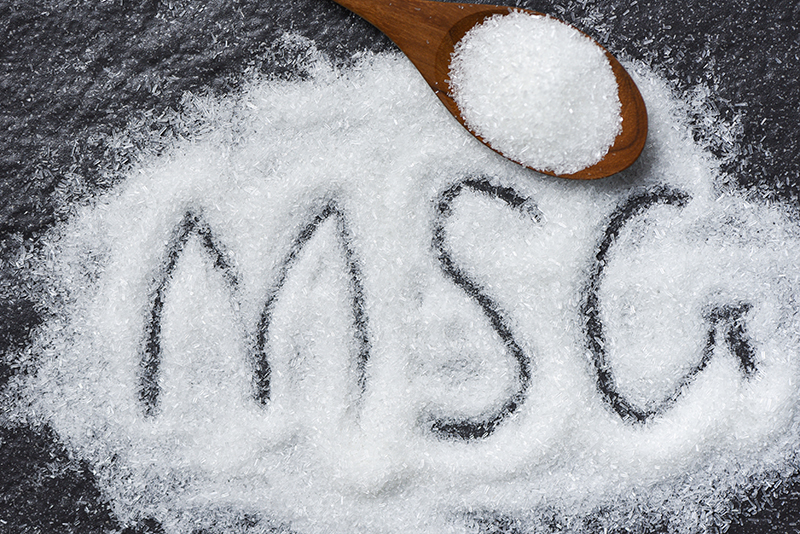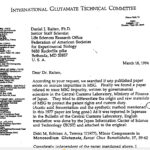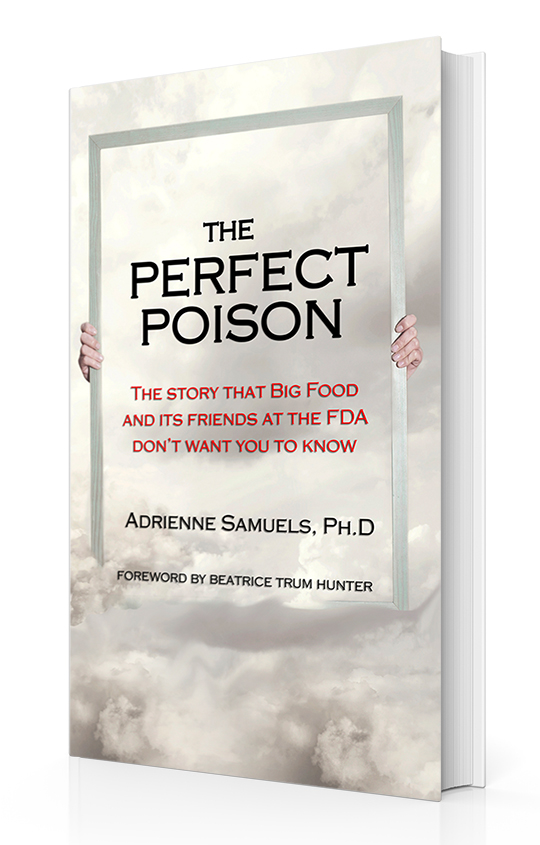A Japanese friend who’s been reading Truth in Labeling Campaign blogs thought we would enjoy sharing this bulletin from the Central Customs Laboratory that so clearly identifies the “Minor components (impurities) in Monosodium Glutamate,” and debunks the glutamate industry propaganda that claims that the glutamate in monosodium glutamate and the unadulterated glutamate found in plants and animals (including humans) are identical.
Is it news or is it propaganda?
If you have enough money and the right contacts, you too can make up your own ‘news’
Ajinomoto, the world’s largest manufacturer of monosodium glutamate (MSG), and its PR firm, Edelman Public Relations, have joined with CBS to recycle the Glutes favorite propaganda pieces disguised as news.
Aired on both CBS Mornings and the network’s highly regarded Sunday Morning show led by veteran journalist Jane Pauley, as well as a Bay area affiliate station, the productions are straight out of the Edelman/Ajinomoto playbook.
The often-repeated blueprint goes like this:
- Use a headline that shows there’s controversy, but not to worry because you can trust that this article/video will give you the real facts:
Yes, MSG has a bad reputation but it’s now making a “comeback.”
“Science” has proven that there’s nothing to worry about!
Things need to be “set straight.”
2. Repeat the well-worn fiction that a 55-year-old letter is responsible for consumers considering that MSG might be toxic. Capitalize on its unique name “Chinese Restaurant Syndrome.” Ignore the multitude of studies clearly demonstrating that MSG causes brain damage.
3. Trot out the “Expert,” who talks about “The Letter” and alludes to how it’s been refuted by “decades of research,” without the expert actually citing any.
4. Bring on the “Chefs,” who will be shown cooking up a storm of delicious food sprinkled with MSG and give some to the reporter to taste. “Yum!”
5. Introduce the xenophobic zinger. This is indeed the perfect example of the diabolical genius of the folks at Edelman PR, filling the airwaves with the concept that avoidance of MSG isn’t based on science, but is actually nothing more than anti-Asian hate speech in disguise.
“Ajinomoto established that deep-rooted xenophobia is at the center of MSG’s complicated history in the U.S.” Edelman stated in a 2019 press release. That seemingly crazy concept is still being repeated.
The Edelman team works long and hard at selling the product they’ve been paid to sell. And they have the media connections to make it happen. But despite the constant use of such expensive and wide-spread propaganda, recognition that MSG is harmful continues to be acknowledged by consumers. It looks like growing numbers of consumers are realizing that they are getting sick following meals that include MSG or some other ingredient that contains its processed free glutamate, and that the more consumers know the harder Ajinomoto and Edelman will work to sell us its disinformation.
Interesting thing about CBS, the network also makes itself available to spin news on behalf of Big Pharma. A January 60 Minutes program was identified as “an unlawful weight loss drug ad” for the med Wegovy by the Physicians Committee for Responsible Medicine. “The 60 Minutes program looked like a news story, but it was effectively a drug ad,” the group Committee said in a press release. PCRM also stated that Novo Nordisk, which makes Wegovy, paid over $100,000 to the doctors CBS interviewed for the segment.
With big PR firms having the media connections to place the stories they want told to appear as legitimate unbiased features, it should make you wonder when you read an article or watch a program: is it news, or is it propaganda?
The slow, steady, thought-altering drip of propaganda
A tip sheet to help fight back when you encounter the glutes’ ‘mishmash’ of altered facts
Effective propaganda doesn’t just hit once and disappear. It works best as a steady stream, most effectively coming at you from all directions. It puts a grain of sand in your oyster of belief, slowly eroding what you thought to be true.
One of the best propaganda campaigns currently out there is being hosted by Ajinomoto, the world’s largest manufacturer of monosodium glutamate. We’ve seen videos, blogs and “news” stories touting the safety of MSG. We’ve been told that avoiding this brain-damaging additive is somehow “racist.” We’ve been informed that it all started with a 1968 letter sent to the New England Journal of Medicine, and that any idea that this toxic substance is dangerous has been debunked by decades of scientific testing. All this disinformation being orchestrated by those in the glutamate industry who don’t mind spending multi-millions to keep generating their ill-gotten billions.
For that reason, we have prepared the following tip sheet for you. Since most of what is circulating is amazingly similar, you can use it for practically any glute hype that comes your way – and that includes articles in newspapers and magazines, Youtube videos and most especially talks on MSG by celebrity chefs and famous foodies.
Tip sheet to cut through the toxic fog of glutamate fiction
Fiction: MSG is made from corn, wheat, and beets
Truth: Since 1957 monosodium glutamate has been manufactured by using genetically modified bacteria to synthesize glutamic acid outside of their cell membranes and excrete it into a medium to accumulate. This “reinvention” has allowed for huge amounts of the additive to be made and used in previously unheard-of amounts in processed foods of all kinds.
Fiction: Avoiding MSG is somehow racist because of the term “Chinese Restaurant Syndrome”
Truth: As you likely know, Chinese Restaurant Syndrome was the title given to a letter written by a physician and sent to the New England Journal of Medicine seeking information about reactions suffered after eating in a Chinese restaurant in the U.S. Why would avoiding this additive – generally done because of personal experiences such as migraines, asthma, depression, heart-rhythm abnormalities, pain, and even seizures – smack of racism?
Fiction: MSG is known to be perfectly safe – “nobody has come up with any science that says there is a problem with it.”
Truth: The studies cited by the Glutes as evidence of MSG safety are ones in which MSG was fed to volunteers who were given test material containing MSG at one time, and at another time given a placebo that contained (without disclosure) an excitotoxic amino acid — one that would trigger the exact same reactions as those caused by MSG. When subjects reacted to both test material and placebo, researchers claimed to have again failed to demonstrate MSG toxicity. More on this subject can be found here.
Ever vigilant in promoting its views, the glutamate industry has declared that both the FDA and regulators around the world have found monosodium glutamate to be safe. In fact, however, neither independent scientists nor independent regulators have found monosodium glutamate to be safe. FDA studies, which were actually reviews, always have been staffed by persons with ties to the glutamate industry. The regulators and/or authoritative bodies referred to by the glutamate industry did no research of their own. And studies to be reviewed were delivered by industry agents. Studies of MSG-induced brain damage were never shown to these authoritative bodies. It’s known that MSG when fed to very young laboratory animals kills brain cells in the area of the hypothalamus, and, through that damage, causes a number of endocrine disorders. One of those disorders is gross obesity. Another is infertility.
Fiction: The glutamate that naturally occurs in many foods and the glutamate in monosodium glutamate are exactly the same
Truth: The glutamate found in unprocessed, unadulterated and unfermented protein is L-glutamate only. The MSG used in cosmetics, drugs, vaccines, dietary supplements and processed food is manufactured, and always contains L-glutamate plus D-glutamate and pyroglutamate (unwanted byproducts of L-glutamate production) plus other unwanted by-products of production all called impurities. And since industry has not found a way to remove the unwanted impurities from processed free L-glutamate, the glutamate in MSG will always come with impurities.
Only manufactured glutamic acid causes brain damage and adverse reaction when ingested or otherwise used. Glutamate contained in unprocessed, unadulterated and unfermented protein, no matter in what quantities, will not cause reactions in MSG-sensitive people.
New name for an old poison
It’s obvious that your PR campaign is working really well when you can influence the Merriam-Webster dictionary to modify the definition of a long-used word.
Such is the case with “savory,” a respectable word meaning pleasant or having high moral standards. In a food sense, savory can be two types of aromatic mints as well as a tasty food that is “spicy or salty but not sweet.” And that’s how savory was defined for a very long time, its first known use being in the 13th century.
But at some point in 2019, as confirmed by the Internet archive way-back machine, Merriam-Webster added additional meanings that include none other than the all-time favorite word of the glutamate industry – umami – now defining savory as the “…taste sensation of umami” and the “taste sensation that is produced by several amino acids and nucleotides (such as glutamate and aspartate)…” (For more on “umami” check out our blog “Umami: the con of the decade?” here).
Savory is also utilized in what’s called the “savory market,” not surprisingly consisting of ingredients that all contain excitotoxic, brain damaging, free glutamic acid, such as: yeast extracts, hydrolyzed vegetable proteins, hydrolyzed animal proteins, monosodium glutamate, and nucleotides.
And that “savory market,” according to a new research report is booming. Of interest, included in that report are references to not just people food, but pet food as well. That makes careful label reading an important part of buying food for all members of your family.
Propaganda. More powerful than research.
Glutamate-industry propaganda is based on industry’s Six Big Fat Lies; on extensive repetition of praise for monosodium glutamate; on disparagement of people who question the safety of monosodium glutamate – all bound up in beautifully wrapped consumer-friendly rhetoric.
The “facts” found in glutamate-industry propaganda come from their Six Big Fat Lies. Use of a particular lie depends on the point that industry is attempting to make, and the audience it’s addressing:
THE SIX BIG FAT LIES:
1) The glutamate contained in MSG is identical to the glutamate in the human body.
2) MSG is very well researched and found to be safe.
3) It must be safe since the FDA has said so.
4) MSG has been used for over a century without adverse reactions.
5) MSG is naturally made, similar to yogurt, vinegar and wine.
6) Monosodium glutamate occurs naturally in food.
Want to know the truth? Go here for answers.
Even the New Yorker parrots the propaganda of the glutamate industry’s pernicious PR campaign with no regrets
Letter sent to New Yorker editor David Remnick. He has yet to respond.
David Remnick
Editor
The New Yorker
Conde Nast
1 World Trade Center
New York, NY 10007
Dear Mr. Remnick,
I am writing to you personally, rather than sending this as a standard letter to the editor, to express my extreme indignation at your magazine’s having spread a blatantly false, misleading and, to a good many people, hazardous piece of industry-generated propaganda under the guise of a restaurant review.
The article to which I’m referring, which appeared both online and in your June 27 issue (and which has just been brought to my attention, or I would have written you sooner) is headlined in the online edition, “AT BONNIE’S MSG IS WIELDED WITH NUANCED ARTISTRY.” The author, Hannah Goldfield, is not only listed as the New Yorker’s food critic but was apparently a former fact-checker for your magazine –which is all the more reason why the outright falsehoods it contains are ones I find so outrageous, being the co-founder and director of the Truth in Labeling Campaign and author of a just-released book titled The Perfect Poison (which details many of my comments here).
To cut to the chase, what Ms. Goldman states at the beginning of this “review”—that “the claim that monosodium glutamate, or MSG, is inherently unhealthy has been thoroughly debunked” is an out-and-out lie—one originating in a disinformation campaign spearheaded by Ajinomoto, a major manufacturer of MSG, and deliberately disseminated using cooperative media outlets to convince people that the negative things they’ve heard about the health effects of the flavor enhancer are baseless rumors.
But it’s not the only falsehood in which Ms. Goldman engages. She also describes MSG as “a salt that’s extracted from fermented crops such as sugarcane and corn” and that MSG “occurs naturally in foods including tomatoes and Parmesan cheese” and furthermore, as being “as harmful as table salt, maybe even less so.”
In reality, there is nothing “natural” about this additive. Monosodium Glutamate is always manufactured. The “found in nature” line is nothing more than spin lifted straight out of the literature of the Glutamate Association. Unlike the bound glutamic acid that occurs in commodities such as tomatoes and Parmesan cheese, as well as meat, grains and vegetables, MSG is comprised of manufactured free glutamate most often produced by using genetically engineered bacteria that secrete glutamate through its cell walls. Manufactured free glutamate will always contain impurities that industry has been unable to remove. MSG does not occur naturally in anything.
While some people might not notice an immediate reaction to ingesting this manufactured flavor enhancer, for others, the effects can be disastrous, resulting in symptoms that can be mistaken for Alzheimer’s or can send someone to the ER. Even the American Heart Association acknowledges it can be a trigger of atrial fibrillation, or AFib.
Another serious consequence of MSG consumption is the neurological damage it can do to children whose blood-brain barriers aren’t fully developed, as well as to many older people by virtue of its being considered an “excitotoxin”—that is, a substance that can literally excite certain brain cells to death, as the late Dr. John Olney, a neuroscientist from Washington University in St. Louis, discovered in the course of his research, leading to its removal from baby food.
Beyond all these health considerations, is the absurd notion expressed by Ms. Goldfield that using MSG is a form of “nuanced artistry” in cooking. This is a lot like saying that the use of performance-enhancing steroids is a form of “nuanced artistry” in athletics.
Lastly, I have to say how personally offensive it is to me, as a degreed educational psychologist and holder of a Ph.D. to have it implied in a nationally respected magazine that I’m guilty of “thinly veiled racism” because I expose the propaganda put forth by the glutamate industry and help the public to decern truth from fiction. How dare your writer make such a totally unfounded and defamatory statement!
In closing, I can only hope that you will take my concerns seriously, make some attempt to retract these fallacious and potentially harmful statements and instruct your writers not to act as conduits for industry propaganda in the future (and your “fact checkers” to make sure they don’t).
Sincerely,
Adrienne Samuels, Ph.D.
Director, The Truth in Labeling Campaign
www.truthinlabeling.org / truthlabeling@gmail.com
How glutamate caused (and continues to cause) the obesity epidemic
I wonder if it’s a conspiracy that’s behind keeping the truth about the obesity epidemic from the public, or if it’s just one immensely powerful person pulling the strings. There has always been propaganda by the boatload, even carried in distinguished publications such as the New York Times and Washington Post. Sometimes as an advertisement. Sometimes dressed up as news. But ever present.
From the time that neuroscientist Dr. John W. Olney discovered that free glutamic acid (a.k.a. glutamate) given to animals killed brain cells in the part of the brain responsible for controlling weight, one rich and powerful manufacturer of glutamate (also the manufacturer of monosodium glutamate – MSG), set out to convince the American public that MSG is a harmless food additive.
The campaign began by pretending to replicate Olney’s studies. That didn’t work out, because they were quickly exposed for what they were, and by 1980 researchers were using MSG to kill neurons and produce obesity in experimental animals to facilitate their research on a whole variety of abnormalities, all with ties to glutamate.
Then, as people began to realize that ingestion of MSG was followed by adverse reactions ranging from simple skin rash to asthma, migraine headache, tachycardia, atrial fibrillation, anaphylaxis and seizures, the Glutes turned to producing double-blind studies that failed to find more reactions to MSG than reactions to a placebo, claiming they now had what amounted to proof that MSG is harmless. But since the placebos all contained excitotoxic amino acids that cause reactions identical to the reactions caused by MSG, they only demonstrated that they were not above doing something that might qualify as scientific fraud.
Now the idea of conspiracy has come back to haunt me. You see, I’ve uncovered the fact that the root of the obesity epidemic lies in damage done to the vulnerable brains of unborn children. I studied the 1970s studies done by Olney and others, thinking that if obesity could be caused by feeding glutamate to infant animals, it could be caused by feeding glutamate to infant humans – or even more effectively to fetuses.
These are the facts:
Olney began with infant animals. Newborn humans and fetuses would be comparable.
Olney began with animals whose brains could be damaged by excitotoxic glutamate. Newborn humans and fetuses would be comparable.
Olney fed exceedingly large amount of glutamate to those animals. Since 1957, exceedingly large amounts of free glutamate have been available, accessible and consumed by humans.
In 1957:
1) the method for producing glutamate (found in MSG) was changed to facilitate virtually unlimited production of free glutamate and MSG, and
2) ultra-processed foods — all of which contain flavor-enhancing free glutamate in ingredients such as autolyzed yeast extract, sodium caseinate, maltodextrin, glutamic acid, and hydrolyzed proteins as well as MSG – became readily available, accessible, and increasingly more popular.
It is true that any one ingredient will contain a limited amount of free glutamate. But glutamate in amounts needed to produce brain damage in vulnerable humans is readily available to those who consume a number of processed and ultra-processed foods during the course of a day.
The glutamate delivered to Olney’s neonatal animals was delivered in food fed to them. The glutamate delivered to humans with vulnerable brains is delivered by their pregnant mothers.
Newborn humans could only receive glutamate in mothers’ milk or infant formula. But fetuses are “fed” through the umbilical cord, through the placenta. And if a pregnant woman ingested large quantities of free glutamate, as she might if her diet included processed and ultra-processed food, the excitotoxic free glutamate would cause damage to the brain of her fetus just as it caused damage to the brains of Olney’s animals. And in humans that brain damage would be followed by intractable obesity just as it was in Olney’s animals.
(And isn’t it interesting that the obesity epidemic has hit hardest in low- income areas — locations with limited access to real food, and a dependence on processed and ultra-processed food).
Journal after journal has refused to publish the information that I have just shared with you. The latest was Obesity, the prestigious journal of The Obesity Society. It is common knowledge among the well informed that medical journals are now controlled by Big Pharma. But that hardly qualifies as a “conspiracy.” It’s just the way things are in the world of power and greed.
But when access to my account in LinkedIn disappeared along with all mention of the Safe Food group that I had established, the word “conspiracy” appeared brightly before me and will not go away.
Also finding its way into my consciousness are the assurances that 1) my description of how the obesity epidemic happened is accurate, and 2) that the Glutes have no way to defend against the truth that manufactured free glutamate consumed by pregnant women lies at the root of the obesity epidemic – except to bury that truth – which their assault on my LinkedIn account demonstrates.
Adrienne Samuels
A new twist to glutamate-industry disinformation
“MSG has an image problem.”
That was the first sentence in the latest online propaganda received by the Truth in Labeling Campaign today.
“An estimated 42% of us are trying to limit or avoid MSG entirely, according to the International Food Information Council,” as reported by Karen Ansel in the TODAY article appearing at msn health — Is MSG bad for your health? The Surprising truth.
Is that an admission or what? Especially coming from the IFIC, an industry front group that’s been representing Ajinomoto, MSG’s U.S. manufacturer, for years. (It was the IFIC that orchestrated the damage control plan for Ajinomoto when concerned about the 60 Minutes program on MSG in 1991.) *
Then Ansel goes on to ask, “Is MSG really as problematic as we’ve been led to believe, or is it time to give it a second look?” And the answer, of course, is that it’s time to give MSG a second look.
From that point forward, the piece reads like much of the glutamate-industry propaganda we’ve seen over the years. As would be anticipated, there’s growing reference to MSG as a salt substitute, ignoring, as always, the downside of substituting excitotoxic amino acids for sodium. But there’s also a hint that authors for glutamate-industry propaganda are getting hard to come by, as evidenced by Ansel giving her article over to Toby Amidor, quoting generously from Amidor who has been representing Ajinomoto for years.
The article concludes by saying: “In the end, if you’re one of those people who is MSG sensitive, it makes sense to avoid it. For everyone else, there’s no need to stress about it.”
Are you serious? No need to stress if you don’t get something you notice like a-fib or headache after consuming MSG? Think about the fact that you won’t be able to notice the brain damage that occurs if you accumulate more glutamate than your body requires.
Resources
Excitotoxins:
https://www.truthinlabeling.org/assets/seven_lines/Seven_Lines_Line1.pdf
“It Wasn’t Alzheimer’s. It Was MSG.” Page 34. https://www.truthinlabeling.org/assets/it_wasnt_az.pdf
PROPAGANDA 101: The 8 ingredients in cutting edge propaganda:
http://truthinlabeling.org/blog/2019/05/01/propaganda-101-the-8-ingredients-in-cutting-edge-propaganda/ Featuring Stefan Chin’s YouTube presentation
Six Big Fat Lies:
https://www.truthinlabeling.org/lies.html
Seven Lines of Evidence leading to the conclusion that manufactured free glutamate, no matter where it is found, is excitotoxic:
https://bit.ly/3vkZ6Cl and https://7lines.org
* 60 Minutes:
The Washington Post?
What do you think it took to get Aaron Hutcherson, a Washington Post food writer of good reputation, to take a propaganda piece advertising a brain-damaging food additive, disguise it as a foodie article and submit it to the Post? And worse yet, have the Post print it.
This isn’t the first time the Post has hosted glutamate-industry propaganda. Caitlin Dewey authored Why Americans still avoid MSG, even though its ‘health effects’ have been debunked on March 20, 2018, and Becky Krystal, a staff reporter for Voraciously covering topics related to food did Embrace umami and learn to add its savory goodness to your foods on February 17, 2020.
Aaron Hutcherson’s article includes much of the standard glutamate-industry propaganda, starting with the statement that Chinese restaurant syndrome is blamed for MSG’s bad reputation. Predictably, that ignores the fact that after MSG and its free glutamate component were reinvented in 1957, people began having reactions after eating MSG and talking to each other about them. Kwok (the doctor who wrote the Chinese restaurant syndrome letter printed in The New England Journal of Medicine) wasn’t the only person who reacted to MSG, but the reactions of others weren’t published.
In the Hutcherson article there’s also the fiction that to react to MSG you have to consume more than 3 grams MSG without food (a fabrication based on the fact that once, in one study, subjects reacted to 3 grams of MSG without food).
Similarly, in studies with subjects said to be MSG-sensitive where they were given MSG or a placebo, the claim is made that scientists have not been able to consistently trigger reactions.
That was guaranteed by giving subjects “placebos” that contained amino acids that caused reactions identical to those caused by the glutamic acid in the MSG test material. In other words, the “placebos” weren’t really placebos.
Then there’s the bit about “The glutamate in MSG is chemically indistinguishable from glutamate present in food proteins. Our bodies ultimately metabolize both sources of glutamate in the same way.” That statement simply ignores the fact that the glutamate in MSG, being manufactured, comes with unwanted by-products of production which inevitably include D-glutamic acid and pyroglutamic acid along with other impurities depending on the materials used to feed the bacteria that produced the MSG and the extent of the processing. The glutamate present on food proteins has none of that.
And of course, there is the brainwashing component of the article, where celebrity chefs applaud MSG’s use, and feel-good words and images are paired with “delicious” MSG.
But Hutcherson also does something just a tad different. Most propaganda pieces say something about the so-called “alleged” dangers of MSG, but Hutcherson doesn’t. So, I’d like to introduce you to the series of blogs that the Truth in Labeling Campaign is doing titled “There are seven lines of evidence leading to the conclusion that the manufactured free glutamate (MfG) in monosodium glutamate is toxic.” The “Overview” was posted on August 24 and “Line 1” was posted on August 26. You can read them at https://bit.ly/3DqyS51 and https://bit.ly/3sUty5g respectively. And there will be more to follow.
Do you think there’s a chance that the Washington Post would even mention those articles? Not since the 1991 60 Minutes program on toxic MSG has any major media in the U.S. even suggested that MSG might be anything other than a harmless food additive.
If you have questions or comments, we’d love to hear from you. If you have hints for others on how to avoid exposure to MfG, send them along, too, and we’ll put them up on Facebook. Or you can reach us at questionsaboutmsg@gmail.com and follow us on Twitter @truthlabeling.
Does changing the name remove the poison?
A change in the approach to glutamate industry propaganda suggests that their 10-million-dollar ad campaign isn’t reaping the profits they were looking for. People know that MSG is toxic and aren’t buying into their deceptive words.
From what we’ve been seeing, the Glutes are banking on a crafty name change — swapping the name MSG for something that will fool enough consumers to keep the profits from selling new-name MSG rolling in.
Any idea what that new name will be? We’re betting that they’re going to work their tails off to rename it umami. After all, they’ve been building that brand for a while now.
If you have questions or comments, we’d love to hear from you. If you have hints for others on how to avoid exposure to MfG, send them along, too, and we’ll put them up on Facebook. Or you can reach us at questionsaboutmsg@gmail.com and follow us on Twitter @truthlabeling.












